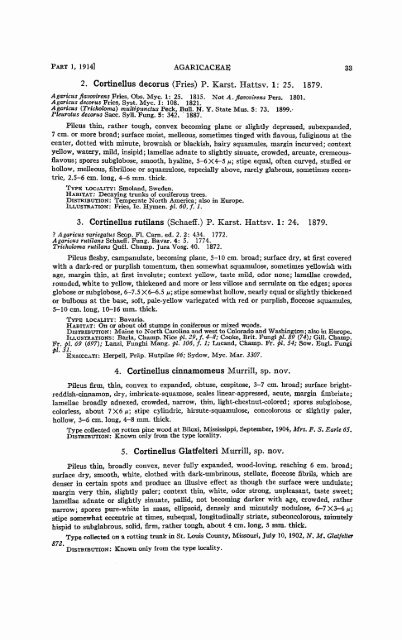North American Flora: Agaricales, Agaricaceae (Vol. 10 ... - MykoWeb
North American Flora: Agaricales, Agaricaceae (Vol. 10 ... - MykoWeb
North American Flora: Agaricales, Agaricaceae (Vol. 10 ... - MykoWeb
Create successful ePaper yourself
Turn your PDF publications into a flip-book with our unique Google optimized e-Paper software.
PART l, 1914] AGARICACEAE 33<br />
2. Cortinellus decorus (Fries) P. Karst. Hattsv. 1: 25. 1879.<br />
Agaricus flavovirens Fries, Obs. Myc. 1: 25. 1815. Not A. flavovirens Pers. 1801.<br />
Agaricus decorus Fries, Syst. Myc. 1: <strong>10</strong>8. 1821.<br />
Agaricus (Tricholoma) multipundus Peck, Bull. N. Y. State Mus. S: 73. 1899.-<br />
Pleurotus decorus Sacc. Syll. Fung. S: 342. 1887.<br />
Pileus thin, rather tough, convex becoming plane or slightly depressed, subexpanded,<br />
7 cm. or more broad; surface moist, melleous, sometimes tinged with flavous, fuliginous at the<br />
center, dotted with minute, brownish or blackish, hairy squamules, margin incurved; context<br />
yellow, watery, mild, insipid; lamellae adnate to slightly sinuate, crowded, arcuate, cremeous-<br />
flavous; spores subglobose, smooth, hyaline, 5-6X4-5 n; stipe equal, often curved, stuffed or<br />
hollow, melleous, fibrillose or squamulose, especially above, rarely glabrous, sometimes eccen-<br />
tric, 2.5-6 cm. long, 4-6 mm. thick.<br />
TYPB LOCALITY: Smoland, Sweden.<br />
HABITAT: Decaying trunks of coniferous trees.<br />
DISTRIBUTION: Temperate <strong>North</strong> America; also in Europe.<br />
ILLUSTRATION: Fries, Ic. Hymen, pi. 60, f. 1.<br />
3. Cortinellus rutilans (Schaeff.) P. Karst. Hattsv. 1: 24. 1879.<br />
? Agaricus variegatus Scop. Fl. Carn. ed. 2. 2: 434. 1772.<br />
Agaricus rutilans Schaeff. Fung. Bavar. 4:5. 1774.<br />
Tricholoma rutilans Quel. Champ. Jura Vosg. 40. 1872.<br />
Pileus fleshy, campanulate, becoming plane, 5-<strong>10</strong> cm. broad; surface dry, at first covered<br />
with a dark-red or purplish tomentum, then somewhat squamulose, sometimes yellowish with<br />
age, margin thin, at first involute; context yellow, taste mild, odor none; lamellae crowded,<br />
rounded, white to yellow, thickened and more or less villose and serrulate on the edges; spores<br />
globose or subglobose, 6-7.5 X6-6.5 /¿; stipe somewhat hollow, nearly equal or slightly thickened<br />
or bulbous at the base, soft, pale-yellow variegated with red or purplish, floccose squamules,<br />
5-<strong>10</strong> cm. long, <strong>10</strong>-16 mm. thick.<br />
TYPE LOCALITY: Bavaria.<br />
HABITAT: On or about old stumps in coniferous or mixed woods.<br />
DISTRIBUTION: Maine to <strong>North</strong> Carolina and west to Colorado and Washington; also in Europe.<br />
ILLUSTRATIONS: Baria, Champ. Nice pi. 29, f. 4-8; Cooke, Brit. Fungi pi. 89 (74); Gill. Champ.<br />
Fr. pi. 69 (697); Lanzi, Funghi Mang. pi. <strong>10</strong>6, f. 1; Lucand, Champ. Fr. pi. 54; Sow. Engl. Fungi<br />
pi. 31.<br />
EXSICCATI: Herpell, Präp. Hutpilze 96; Sydow, Myc. Mar. 3307.<br />
4. Cortinellus cinnamomeus Murrill, sp. nov.<br />
Pileus firm, thin, convex to expanded, obtuse, cespitóse, 3-7 cm. broad; surface bright-<br />
reddish-cinnamon, dry, imbricate-squamose, scales linear-appressed, acute, margin fimbriate;<br />
lamellae broadly adnexed, crowded, narrow, thin, light-chestnut-colored; spores subglobose,<br />
colorless, about 7X6 n; stipe cylindric, hirsute-squamulose, concolorous or slightly paler,<br />
hollow, 3-6 cm. long, 4-8 mm. thick.<br />
Type collected on rotten pine wood at Biloxi, Mississippi, September, 1904, Mrs. F. S. Earle 65.<br />
DISTRIBUTION: Known only from the type locality.<br />
5. Cortinellus Glatfelteri Murrill, sp. nov.<br />
Pileus thin, broadly convex, never fully expanded, wood-loving, reaching 6 cm. broad;<br />
surface dry, smooth, white, clothed with dark-umbrinous, stellate, floccose fibrils, which are<br />
denser in certain spots and produce an illusive effect as though the surface were undulate;<br />
margin very thin, slightly paler; context thin, white, odor strong, unpleasant, taste sweet;<br />
lamellae adnate or slightly sinuate, pallid, not becoming darker with age, crowded, rather<br />
narrow; spores pure-white in mass, ellipsoid, densely and minutely nodulose, 6-7 X 3-4 M ;<br />
stipe somewhat eccentric at times, subequal, longitudinally striate, subconcolorous, minutely<br />
hispid to subglabrous, solid, firm, rather tough, about 4 cm. long, 5 mm. thick.<br />
Type collected on a rotting trunk in St. Louis County, Missouri, July <strong>10</strong>, 1902, N. M. Clatfelter<br />
872. DISTRIBUTION: Known only from the type locality.
















